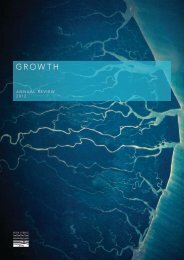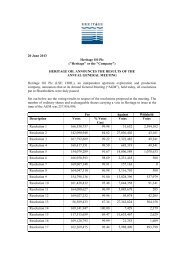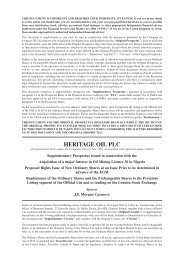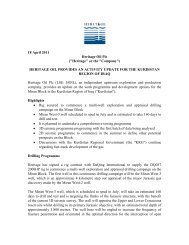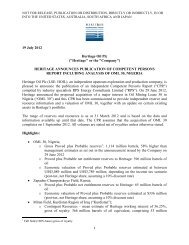- Page 1 and 2:
This document comprises a prospectu
- Page 3 and 4:
SUMMARY INFORMATIONThis summary mus
- Page 5 and 6:
Summary Consolidated Income Stateme
- Page 7 and 8:
Summary Consolidated Cash Flow Stat
- Page 9 and 10:
Production from the Zapadno Chumpas
- Page 11 and 12:
Given the geographic spread of the
- Page 13 and 14:
RISK FACTORSAny investment in the O
- Page 15 and 16:
wells may change as a result of low
- Page 17 and 18:
which could have a materially adver
- Page 19 and 20:
Failure to obtain additional financ
- Page 21 and 22:
contractual or pricing terms, both
- Page 23 and 24:
years. In addition, since December
- Page 25 and 26:
UgandaUganda is among the poorest c
- Page 27 and 28:
Market Price of the Ordinary Shares
- Page 29 and 30:
DIRECTORS, CORPORATE SECRETARY, SEN
- Page 31 and 32:
EXPECTED TIMETABLE OF PRINCIPAL EVE
- Page 33 and 34:
CurrenciesAll references in this do
- Page 35 and 36:
PART I—INFORMATION ON THE GROUPOV
- Page 37 and 38:
Strong management and technical tea
- Page 39 and 40:
the availability of existing infras
- Page 41 and 42:
In 2005, the Group acquired a 95 pe
- Page 43 and 44:
The Group acquired a 10 per cent. i
- Page 45 and 46:
The Group is the operator and has a
- Page 47 and 48:
exploration wells. The total estima
- Page 49 and 50:
The Group has also entered into a s
- Page 51 and 52:
Pakistan has current proved hydroca
- Page 53 and 54:
operational by drawing up an Enviro
- Page 55 and 56:
Mr. Buckingham has never had any as
- Page 57 and 58: Date2007 ........ On 18 January 200
- Page 59 and 60: (3) One common share of Heritage Ho
- Page 61 and 62: (f) General Sir Michael WilkesGener
- Page 63 and 64: Remuneration CommitteeThe Remunerat
- Page 65 and 66: Goldsworth House, Denton Way, Golds
- Page 67 and 68: ResourcesA summary of the gross Con
- Page 69 and 70: The post tax Net Present Value (NPV
- Page 71 and 72: RPS EnergyHeritage Oil - Competent
- Page 73 and 74: RPS EnergyHeritage Oil - Competent
- Page 75 and 76: RPS EnergyHeritage Oil - Competent
- Page 77 and 78: RPS EnergyHeritage Oil - Competent
- Page 79 and 80: RPS EnergyHeritage Oil - Competent
- Page 81 and 82: RPS EnergyHeritage Oil - Competent
- Page 83 and 84: RPS EnergyHeritage Oil - Competent
- Page 85 and 86: RPS EnergyHeritage Oil - Competent
- Page 87 and 88: RPS EnergyHeritage Oil - Competent
- Page 89 and 90: RPS EnergyHeritage Oil - Competent
- Page 91 and 92: RPS EnergyHeritage Oil - Competent
- Page 93 and 94: RPS EnergyHeritage Oil - Competent
- Page 95 and 96: RPS EnergyHeritage Oil - Competent
- Page 97 and 98: RPS EnergyHeritage Oil - Competent
- Page 99 and 100: RPS EnergyHeritage Oil - Competent
- Page 101 and 102: RPS EnergyHeritage Oil - Competent
- Page 103 and 104: RPS EnergyHeritage Oil - Competent
- Page 105 and 106: RPS EnergyHeritage Oil - Competent
- Page 107: RPS EnergyHeritage Oil - Competent
- Page 111 and 112: RPS EnergyHeritage Oil - Competent
- Page 113 and 114: RPS EnergyHeritage Oil - Competent
- Page 115 and 116: RPS EnergyHeritage Oil - Competent
- Page 117 and 118: RPS EnergyHeritage Oil - Competent
- Page 119 and 120: RPS EnergyHeritage Oil - Competent
- Page 121 and 122: RPS EnergyHeritage Oil - Competent
- Page 123 and 124: RPS EnergyHeritage Oil - Competent
- Page 125 and 126: RPS EnergyHeritage Oil - Competent
- Page 127 and 128: RPS EnergyHeritage Oil - Competent
- Page 129 and 130: RPS EnergyHeritage Oil - Competent
- Page 131 and 132: RPS EnergyHeritage Oil - Competent
- Page 133 and 134: RPS EnergyHeritage Oil - Competent
- Page 135 and 136: Summary Consolidated Balance Sheets
- Page 137 and 138: Summary Consolidated Balance Sheets
- Page 139 and 140: locks during the first three and a
- Page 141 and 142: On 2 October 2007, the Group execut
- Page 143 and 144: of amplitude anomalies, further sup
- Page 145 and 146: The increase in operating expenses
- Page 147 and 148: 5.11 Discontinued OperationsThe res
- Page 149 and 150: 6. RESULTS OF CONTINUING OPERATIONS
- Page 151 and 152: 6.7 Foreign Exchange LossesThere wa
- Page 153 and 154: 6.14 Capital ExpendituresThe follow
- Page 155 and 156: 7.3 Petroleum and Natural Gas Reven
- Page 157 and 158: 7.14 Capital ExpendituresAdditions
- Page 159 and 160:
10. LIQUIDITY AND CAPITAL RESOURCES
- Page 161 and 162:
Year Ended 31 December 2005 Prepare
- Page 163 and 164:
Intangible E&E assets related to ea
- Page 165 and 166:
11.2 The year ended 31 December 200
- Page 167 and 168:
(c) Reconciliation of loss for the
- Page 169 and 170:
Year Ended 31 December 2004 Prepare
- Page 171 and 172:
PART VII—FINANCIAL INFORMATIONA.
- Page 173 and 174:
DeclarationFor the purposes of Pros
- Page 175 and 176:
HERITAGE OIL LIMITEDNOTES TO BALANC
- Page 177 and 178:
AUDITED AND UNAUDITED FINANCIAL INF
- Page 179 and 180:
HERITAGE OIL CORPORATIONCONSOLIDATE
- Page 181 and 182:
HERITAGE OIL CORPORATIONCONSOLIDATE
- Page 183 and 184:
HERITAGE OIL CORPORATIONNOTES TO CO
- Page 185 and 186:
Intangible E&E assets related to ea
- Page 187 and 188:
k) InvestmentsThe Group classifies
- Page 189 and 190:
usually when legal title passes to
- Page 191 and 192:
iii) IFRIC 12, ‘‘Service conces
- Page 193 and 194:
v) Liquidity riskLiquidity risk is
- Page 195 and 196:
ii) DerivativesDerivatives are reco
- Page 197 and 198:
5 Other finance costsNine-month per
- Page 199 and 200:
Congo to the other partners in the
- Page 201 and 202:
No assets have been pledged as secu
- Page 203 and 204:
31 December 30 September2005 2006 2
- Page 205 and 206:
16 Trade and other payables31 Decem
- Page 207 and 208:
A reconciliation of the asset retir
- Page 209 and 210:
21 Loss per shareThe following tabl
- Page 211 and 212:
25 Commitments and contingenciesHer
- Page 213 and 214:
In November 2007, the Group farmed-
- Page 215 and 216:
Reconciliation of loss for the year
- Page 217 and 218:
At the end of the last reporting pe
- Page 219 and 220:
Reconciliation of cash flow stateme
- Page 221 and 222:
At 31 December 2006, this has resul
- Page 223 and 224:
AUDITED FINANCIAL STATEMENTS RELATI
- Page 225 and 226:
AUDITORS’ REPORT TO THE SHAREHOLD
- Page 227 and 228:
HERITAGE OIL CORPORATIONCONSOLIDATE
- Page 229 and 230:
HERITAGE OIL CORPORATIONNOTES TO CO
- Page 231 and 232:
effective as hedges, both at incept
- Page 233 and 234:
A ceiling test was undertaken at De
- Page 235 and 236:
6. Share capital:(a) Authorized:Unl
- Page 237 and 238:
fair value of stock options are amo
- Page 239 and 240:
C. PRO FORMA FINANCIAL INFORMATION
- Page 241 and 242:
PRO FORMA NET ASSET STATEMENTThe fo
- Page 243 and 244:
Production assumptionsProduction du
- Page 245 and 246:
Macroeconomic assumptionsThe Direct
- Page 247 and 248:
Accordingly, the Illustrative Proje
- Page 249 and 250:
Arrangement AgreementPursuant to th
- Page 251 and 252:
PART X—ADDITIONAL INFORMATION1. R
- Page 253 and 254:
(ii) no share or loan capital of th
- Page 255 and 256:
(j)In Alberta, the principal jurisd
- Page 257 and 258:
nominal amount has been paid up of
- Page 259 and 260:
instrument of transfer (in the case
- Page 261 and 262:
up on all the shares conferring tha
- Page 263 and 264:
(B) may be a director or other offi
- Page 265 and 266:
and is in default for a period of 1
- Page 267 and 268:
(c)have sufficient moneys, assets o
- Page 269 and 270:
(e)against surrender of the Exchang
- Page 271 and 272:
e, to the extent that the same is r
- Page 273 and 274:
(g)(ii) by arranging for the credit
- Page 275 and 276:
(b) rights, options or warrants oth
- Page 277 and 278:
any provision of provincial, territ
- Page 279 and 280:
7.5 None of the major shareholders
- Page 281 and 282:
Position stillDirector/Senior Manag
- Page 283 and 284:
employment or terminates his or her
- Page 285 and 286:
All rights of a holder of Exchangea
- Page 287 and 288:
agreement of this nature. These cir
- Page 289 and 290:
to change. Where the Company pays a
- Page 291 and 292:
As part of an agreement reached in
- Page 293 and 294:
(x) Foreign Property Information Re
- Page 295 and 296:
19. DOCUMENTS AVAILABLE FOR INSPECT
- Page 297 and 298:
declared and unpaid dividends on ea
- Page 299 and 300:
‘‘DTR’’‘‘DutchCo’’
- Page 301 and 302:
‘‘ISIN’’‘‘ITA’’‘
- Page 303 and 304:
anniversary of the Effective Date a
- Page 305 and 306:
‘‘Support Agreement’’‘‘
- Page 307:
emaining quantities recovered will



